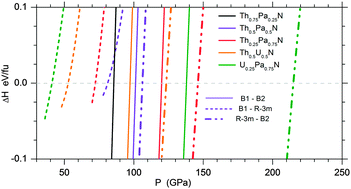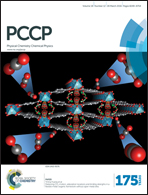Role of 5f electrons in the structural stability of light actinide (Th–U) mononitrides under pressure
Abstract
Pressure induced structural sequences and their mechanism for light actinide (Th–U) mononitrides were studied as a function of 5f-electron number using first-principles total energy and electronic structure calculations. Zero pressure lattice constants, bulk module and C11 elastic module vary systematically with 5f-electron number implying its direct role on crystal binding. There is a critical 5f-electron number below which the system makes B1–B2 and above it B1–R![[3 with combining macron]](https://www.rsc.org/images/entities/char_0033_0304.gif) m–B2 structural sequence under pressure. Also, the B1–B2 transition pressure increases with increasing 5f-electron number whereas an opposite trend is obtained for the B1–R
m–B2 structural sequence under pressure. Also, the B1–B2 transition pressure increases with increasing 5f-electron number whereas an opposite trend is obtained for the B1–R![[3 with combining macron]](https://www.rsc.org/images/entities/char_0033_0304.gif) m transition pressure. The ascending of N p anti-bonding states through the Fermi level at high pressure is responsible for the structural instability of the system. Above the critical 5f-electron number in the system a narrow 5f-band occurs very close to the Fermi level which allows the system to lower its symmetry via band Jahn–Teller type lattice distortion and the system undergoes a B1–R
m transition pressure. The ascending of N p anti-bonding states through the Fermi level at high pressure is responsible for the structural instability of the system. Above the critical 5f-electron number in the system a narrow 5f-band occurs very close to the Fermi level which allows the system to lower its symmetry via band Jahn–Teller type lattice distortion and the system undergoes a B1–R![[3 with combining macron]](https://www.rsc.org/images/entities/char_0033_0304.gif) m phase transition. However, below the critical 5f-electron number this mechanism is not favorable due to a lack of sufficient 5f-state occupancy and thus the system undergoes a B1–B2 phase transition like other ionic solids.
m phase transition. However, below the critical 5f-electron number this mechanism is not favorable due to a lack of sufficient 5f-state occupancy and thus the system undergoes a B1–B2 phase transition like other ionic solids.


 Please wait while we load your content...
Please wait while we load your content...